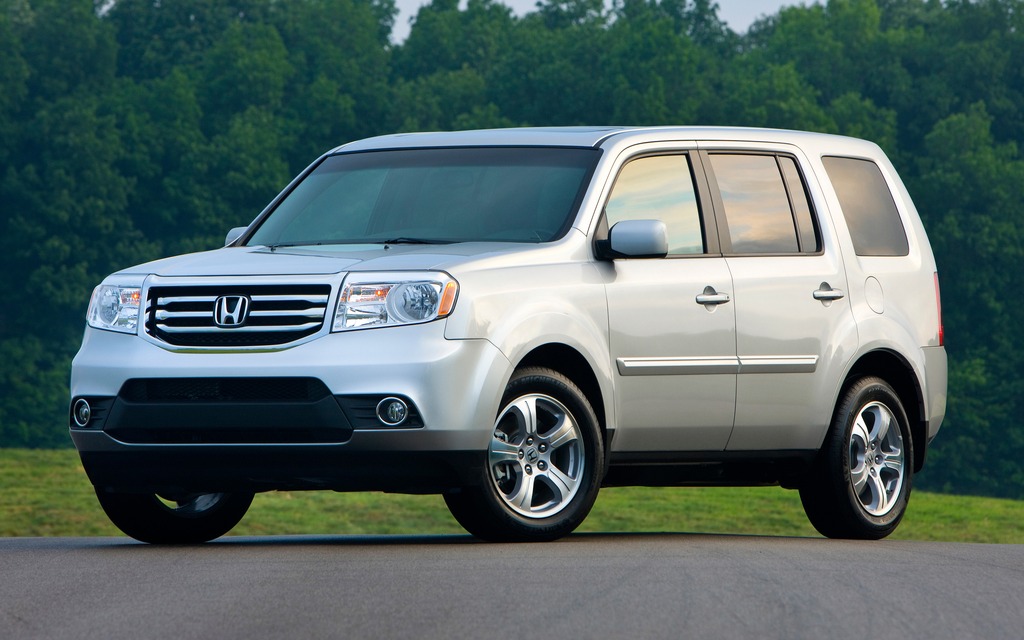2012 Honda Pilot: The evolution of the automobile

| Strong points |
|
|---|---|
| Weak points |
|
These days, things seem to be shrinking to the point that they are practically microscopic (you should see the incredibly small video camera that I got for Christmas and that I’ll never use to more than 20% of its potential). And in this miniature world, engines have fewer cylinders but more horsepower thanks to the wonders of turbocharging. All this makes vehicles like the Honda Pilot look like dinosaurs, despite their obvious modernism and sophistication.
In the same Jurassic category are the Chevrolet Traverse, Ford Flex and Subaru Tribeca. These mid-size SUVs offer seven or eight seats and demonstrate handling that is at least on par with that of a sports car – from 30 years ago.
The laws of physics
Consider the Honda Pilot that I test drove for three weeks last fall. This imposing SUV weighs more than 2,000 kilos and features a 3.5-litre V6 producing 250 horsepower and 253 lbs.-ft. of torque. Needless to say, it wouldn’t stand a chance in a quarter-mile versus a 201-horsepower Civic Si: it’s a matter of physics, plain and simple. I doubt that the Pilot was designed for this type of activity, however, and the fact that it can accelerate from 0 to 100 km/hr in less than 9.0 seconds (8.8 to be precise) is more than satisfactory.
Its completely independent suspension isn’t uncomfortable, but it can bang pretty hard on certain bumps. The body leans in curves, but not disproportionately for an SUV. If a Porsche Boxster leaned that much, however, I’d be outraged! The steering is surprisingly precise for such a mastodon – although when you’re zigzagging, it becomes tough in the centre. In fact, the limit of its handling is determined more by the seats that hold poorly in turns than by the mechanical elements. At 47.1 metres, the braking distance at 100 km/hr is rather long, compared to 45.9 for a Chevrolet Traverse, 40.9 for a Flex and 40.5 for a Tribeca (according to the AJAC).
Everything in moderation
The Pilot makes up for its barely passable brakes by controlling its appetite at the pump. The first week of our test drive was divided evenly between the city, back roads and highway. The average fuel consumption recorded by the on-board computer was 12.8 L/100 km, which is excellent considering the weight of the vehicle. The next week, on a trip to Niagara-on-the-Lake, Ontario, via the always exciting 401, our average was 10.9 L/100 km. If we didn’t have such a lead foot on the return journey, my colleague Marie-Ève and I perhaps could have lowered this average to 10.0 L/100 km. These averages were recorded by the on-board computer.
However, if the five-speed automatic transmission (the shifting isn’t very fast, by the way) had one or two more gears (like the very stiff competition), the Pilot’s fuel consumption would drop even lower. At 100 km/hr, the engine revs at 2,000 rpm (at 120, it revs at 2,500). That’s a tad too high for this type of vehicle. This will surely be corrected when the next version is unveiled, probably this year as a 2014 model.
Spacious
Life on board a Pilot is very pleasant. It’s silent – thank you Michelin Primacy (235/60R18) tires – and very comfortable (even after several hours, whether you’re in front, in the middle or even in the back). Sure, I wouldn’t have done Montreal to Niagara-on-the-Lake non-stop in the third row, and definitely not in the middle seat, but it’ll do the job in a pinch. Its interior space is most impressive. At a certain point during our week away in Ontario, there were four of us and the trunk managed to hold everyone’s bags (of which there were many!). If that wasn’t enough, there are storage spaces under the trunk floor.
There’s no shortage of storage in front, either. The instrumentation directly in front of the driver is beautiful and easy to read. The central console overflows with buttons and once you’re accustomed to the layout, it’s very intuitive. All those windows make the passenger compartment brighter and, more importantly, provide good overall visibility.
At more than $48,000, our Honda Pilot Touring sure isn’t cheap. But it isn’t a rip-off either. Sure, it isn’t the best equipped or least expensive in its category, but its overall refinement, its reliability and its respectable fuel consumption make it a choice vehicle. Moreover, it has high-performance all-wheel drive (there’s a front-wheel drive version but it isn’t very interesting) and a very high 2,045 kg (4,500 lbs.) towing capacity. Only the Chevrolet Traverse outdoes it with 2,359 kg (5,200 lbs.).
The next Pilot
Rumor has it that the Pilot is on the verge of being replaced by a new, more modern version. I bet that the transmission will gain at least one gear, that the dashboard will get rid of several buttons and that the shape will finally be updated. Don’t worry, we’ll keep you posted. In the meantime, if you get your hands on the current-generation Pilot, unveiled in 2009, you won’t be disappointed. It’s a mature vehicle, ready to move on to bigger and better things.











